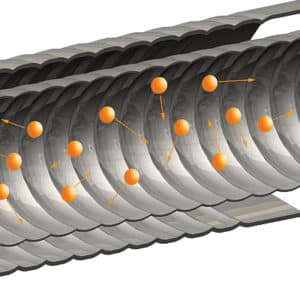Heat Transfer Fundamentals

As noted here, the basic principle of heat transfer is extremely simple, two fluids at different temperatures are placed in contact with a conductive barrier (the tube wall) and heat is transferred from the hotter fluid to the colder fluid until they reach the same temperature level. In industrial processes, this is carried out in heat exchangers of various types and styles usually purpose built for the process and site conditions of the application.
This section deals with key elements of heat exchange theory and heat exchanger design which are not covered elsewhere in the Resources section.
Fluid Types
The fluids for both product and service systems with which the heat exchanger designer has to work are as varied as the processes which use heat exchangers. They can however, be classified into two very broad categories:
- Newtonian – Where the inherent property defined as viscosity is independent of the rate of shear within the fluid.
- Non-Newtonian – Where the inherent property defined as viscosity is dependent on the rate of shear within the fluid.
In simple terms, the effective viscosity of a Newtonian fluid does not depend on the velocity with which it flows through a pipe or tube but for a Non-Newtonian fluid it does.
As well as the viscosity of the working fluids four other properties are of major importance when modeling heat transfer performance.
- Density – the mass of the fluid per unit volume which directly affects the velocity with which the fluids flow through a system.
- Specific heat – the amount of heat which a given mass of a fluid requires for the temperature to be changed by 1°.
- Thermal conductivity – the rate at which heat can flow through a fluid.
- Latent heat – the amount of heat which a given mass of a substance requires to change state – that is to melt if it is a solid, freeze if it is liquid, evaporate if it is a liquid or condense if it is a gas.
Equally important from the operational point of view are the corrosion characteristics of the fluid which influence the final choice of materials of construction that the designer must use.
It is particularly important to identify fluids which are known to be high in chlorides as these can lead to stress corrosion cracking in some grades of stainless steel but any high acidity or alkalinity fluids should be checked with an expert metallurgist to confirm material suitability. In applications such as exhaust gas cooling it is important to check for condensation on the tube wall and the composition of the gas (or fuel) to check if any acids will form as the gas is cooled. If condensation is confirmed and the gas or fuel contains any Sulfur compounds then the assistance of an expert metallurgist should again be sought for advice on suitable materials.
The Purpose of Expansion Bellows
Most of the standard HRS series heat exchangers are manufactured as fixed tube units and are normally fitted with a thin wall multi-convolution expansion compensator (or bellows) to allow for the differential expansion between the shell pipe and the tubes. It is vitally important that the bellows unit is designed correctly and HRS Heat Exchangers follows the recommendations of the Expansion Joint Manufacturers Association (TEMA) of America.
This means that the worst case conditions of pressure, temperature and differential expansion are identified (which may be a CIP or other non-working condition) for use in the design calculations. TEMA stresses that heat exchangers are not intended to act as pipe work anchor points. If the pipe work designer does not account for the expansions and contractions produced under all operational conditions and allows them to impose external loads onto the heat exchanger connections then both bellows and nozzle pipes can be damaged.
Connections
Connections form an important part of any heat exchanger as they provide the interface between the unit and the system pipe work. It is essential for the safe and convenient working of the equipment that the type of connection is chosen carefully to satisfy the safety requirements for the design pressure and temperature and the clients’ requirements for convenience and suitability for the process. If a heat exchanger is going to be removed for cleaning on a regular basis then quick release clamps may be a more appropriate choice than bolted flanges.
Both flanges and the various styles of quick release clamps offered by suppliers are limited in working pressure and temperature. It is essential that whichever style of connection is specified by the end user (or offered by the designer) the temperature and pressure ratings of the connection are checked to confirm acceptability. The process compatibility of the gasket or seal material used for the connection must always be checked. There is a range of materials available for most connection types and the one chosen must be appropriate for the working fluids.
The size of the connection is also important. This will often be specified by the installer but the heat exchanger designer must be aware of the implications of the sizes chosen. Mechanical considerations also affect the choice of nozzle. Essentially the bigger the hole in the shell the weaker the shell will become and under pressure vessel rules the weakening effect must be checked and if necessary reinforcement added in the nozzle area.
Contact Us for more information